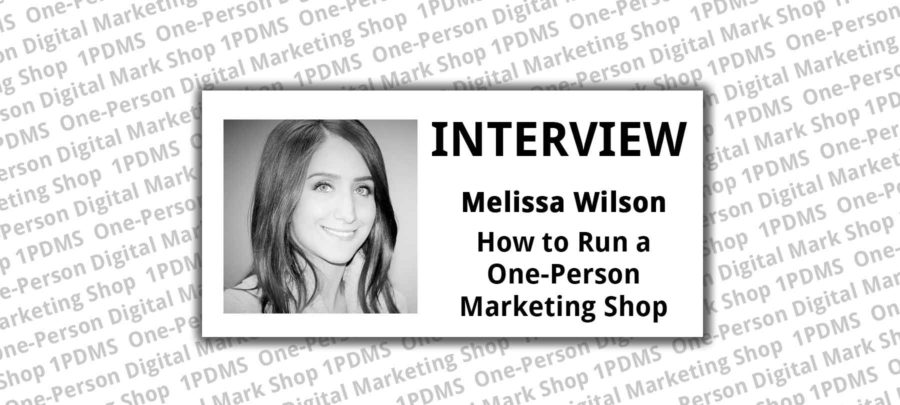By Chris Karel
Melissa Wilson’s career spans nine years in integrated communications and digital marketing. She’s a practical influencer who facilitates the transfer of ideas and objectives, gathers feedback to improve ideas and objectives in order to understand the audience, and develops a brand-compliant narrative to reach them. In doing so, Wilson helps her company navigate their path to awareness, consideration, engagement and retention. While her methodology can be unconventional, Wilson will make certain marketing focuses on revenue generation and conversion. Recently, she sat down with AMA NEO Digital SIG programming director Chris Karel to discuss how to run a one-person digital marketing shop.
Chris: Here we go Melissa. Let’s start with what is a one-person digital marketing shop?
Melissa: Ultimately, they are a strategist who is responsible for deciding on and overseeing digital marketing efforts. This person will (get to) understand your company, competitors, market, and buyer personas to implement a sound strategy.
Chris: What kind of skills does this person need to have in order to be successful?
Melissa: Filling the role can be tricky as the strategist must be analytical, creative, and an overall generalist as they tap into and retain other disciplines within the marketing umbrella. This person needs to see the big picture, outside of their own specialties, to figure out how to get results. For example, the strategist may retain vendors for SEM, graphic design, and technical support (i.e., HTML and CSS). Such roles are laborious and require an expert, not a generalist. No one should have to endure my graphic design capabilities.
Chris: What is the first thing a one-person digital marketer should do when they get into the position?
Melissa: The most common mistake I see is giving in to the urge to make a smaller yet immediate connection in order to receive a stronger or more enduring relationship later. The relationship may apply externally to clients and prospects or it may apply internally to coworkers, vendors, and influencers. Maybe they’re jeopardizing both.
Chris: So, what should they do instead?
Melissa: The first thing you should do is put on a project manager hat (a white fedora with navy ribbon for me!) and get ready for one hell of a ride as you commit resources to: exploring current operational structure and practices; technology and capabilities; internal collaborators and influencers; competitors and the buying landscape; past and current market trends; demographic and/or firmographic profiles; and the company’s past adventures in marketing.
Chris: I like it. So, after you put on the white fedora with the navy ribbon (har, har), what will you hope to yield from committing to those resources?
Melissa: You want to produce a one, three, and five year plan with budget and a project rollout. Remember, committing resources to executing this process every year will paint a realistic picture of your research and evaluation and how these opportunities apply to your plan.
Chris: That makes sense, how about sharing two or three tools that the one-person marketing shop should always be using?
Melissa: In a newly created role, grace, eloquence, and CORE communication will be your best friend. Always use them.
Chris: Sounds like white fedora wisdom to me. More specifically, will you share some application tools that you’ve found useful to the one-person marketing shop?
Melissa: Absolutely, I’d say automation and API keys are critical to your efficiency (and sanity). This includes automating analytics for reports (i.e., Google Analytics), CMS for content execution (i.e., WordPress or the comprehensive Marketo), CRM for sales cycle (i.e., SalesForce), and communications software for content delivery (i.e., Constant Contact or Autopilot).
Chris: Tell me more about the API keys. What’s the benefit?
Melissa: Setting up API keys between programs allows them to interface with each other, which means they collect the information you tell them to collect and it’s available to execute when you’re ready. For example, setting up an API key in Constant Contact for SalesForce allows you to funnel your leads into Constant Contact and/or Marketo for email blasts, SMS, etc. You can even setup segmentation so these leads are funneled into the proper list.
Chris: Definitely something I’d like to learn more about, thanks for sharing. Next, let’s shift gears a bit and talk about integration. Why should marketers care about using integration in their departments, large or small?
Melissa: Integration ensures that your communication is consistent, regardless of the channel that it is used or the vehicle used to deliver the message. It brings it all together. It is loyal to your overall strategy as it shares the same messaging in a different manner to different parties across different channels.
Integration is critical in making sure internal parties are unified while it drives the experience of external parties so they understand and appreciate your message. This reinforcement strengthens the outcome by increasing the chances your external parties will take action and your internal parties will support that action.
Chris: That may be one of the greatest challenges all marketers face regardless of the size of his or her team. Last question, I always ask this of every marketer because I think it gets lost in the industry too often. What do you do to increase conversions?
Melissa: Pay attention to the sales cycle and where each group and/or individual falls within that cycle and act-fast.
Chris: Thank you Melissa. I appreciate you taking the time to talk with me and share your knowledge with me.
More about Melissa Wilson
Linkedin – Twitter – Keis George Blog
More about Chris Karel
LinkedIn – Twitter – Cinécraft Productions
Don’t miss Melissa Wilson as an upcoming guest speaker for our November Digital SIG.

